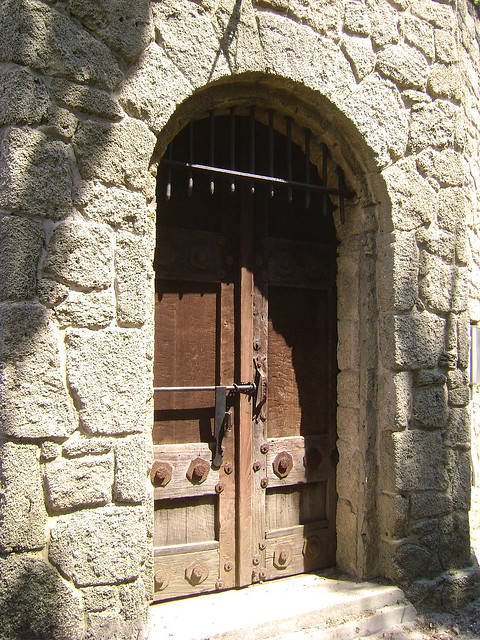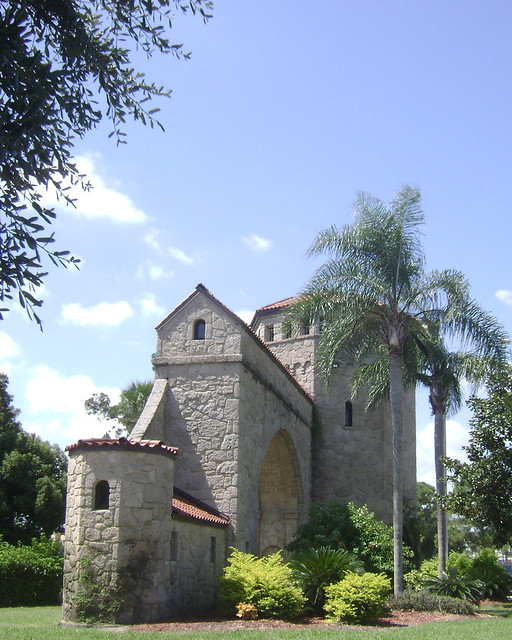The Tarragona Tower




This architectural
monument looks like a bit of Camelot or Carcassonne somehow magically removed to
Central Florida. It is a familiar landmark to anyone heading into Daytona Beach.
The story behind it is worth telling.
...
It was built to be
one of two gateways into a 1920s development called "Coquina Highland" (later
renamed "Daytona Highlands"). You still enter the Daytona
Highlands neighborhood by turning on to Tarragona Way at the historic Tarragona
Arch.
...
The Tarragona Tower
is sometimes said to have been designed by "architect Charles Ballough" and that
may be so, but I have had a hard time finding any references apart from this
building that say Ballough was an architect. He WAS an early settler in Daytona
in the days when it was first becoming a destination for snowbirds. Charles A.
Ballough was born in Wisconsin in 1856, the son of William and Ann Ballough who
had come to the United States from England. In 1880 they, as well as Charles'
brothers Wiliam and James were living in Daytona. They were orange grove
planters, as were their neighbors, the Blivins, Corps and Mitchells. But change
was in the wind.
...
In 1885, Charles A.
Ballough built a large beach cottage north of the Rogers development, at the end
of Ocean Boulevard, in the Seabreeze area of Daytona Beach. Although it was a
summer residence for the Wisconsin native at first, the cottage was soon
expanded and named “The Clarendon”. This cottage was to become what we now know
as the Plaza Resort. In the spring of 1895, Ballough formed a partnership with
another local business man. The two combined their properties including the
Clarendon, the Breakers (on the North side) and a 1,200 foot pier (on the
South). With the successful partnership, the Clarendon and the Breakers were
joined as “The Clarendon Hotel". He later bought the property to the north as
far as University Boulevard, and platted the entire tracts into streets and town
lots.
...
Circa 1920 Ballough
was involved in the identification of the Addison Blockhouse, in Volusa County.
He also held a 1915 patent on a submarine vessel. Ballough was the author of the
book, "The Power That Heals and How to Use It" (1902), which is still in print,
the author being described as a metaphysical teacher and famous healer through
harmonious suggestions. A man of many parts, it is hard to find any clear
evidence that he did architectural work.
...
Other references
say that the Taragonna Tower was designed by the noted Florida landscape artist
Don J. Emery. Don J. Emery was a mural painter and wood engraver, and also
director of the Daytona Beach Art School. In addition to designing and
illustrating "A Map of Florida for Garden Lovers" (1934), he provided the maps
and decorations for the book "Florida's Golden Sands" (1950) by Alfred Jackson
Hanna and Kathryn Abbey Hanna.
It may be that both
men had a hand in the design of the Tower. I do know that Don J. Emery continued
to live in the Daytona Highlands neighborhood for most of his
life.
...
The Tarragona Tower was built of coquina rock that had been taken from the property on which it was constructed. The octagon-shaped, 45-foot tall tower and arch in Daytona Beach was built in 1926 as the entrance to a 1,000-acre subdivision called Daytona Highlands. It was designed after an octagonal medieval tower in Tarragona, Spain, which you can find fairly easily if you do an on line search. Arches in the same city are said to have also influenced the design. The Florida version was considered the most impressive of all Florida neighborhood entrances when it was built.
...
The Tarragona Tower was built of coquina rock that had been taken from the property on which it was constructed. The octagon-shaped, 45-foot tall tower and arch in Daytona Beach was built in 1926 as the entrance to a 1,000-acre subdivision called Daytona Highlands. It was designed after an octagonal medieval tower in Tarragona, Spain, which you can find fairly easily if you do an on line search. Arches in the same city are said to have also influenced the design. The Florida version was considered the most impressive of all Florida neighborhood entrances when it was built.
...
The original design
consisted of a grand tower with two arches. When International Speedway
Boulevard (then named Volusia Avenue) was widened in the 1940's, one arch was
removed. When the road was widened again in the 1980's, the arch was moved to
avoid demolition. A complete restoration was recently completed in 2004; the
restoration received a Florida Trust for Historic Preservation award in 2006.
...
The arch is now
considered a city historic landmark, and rightly so. It is beautifully designed
and quality construction and quite unlike anything else in Florid
No comments:
Post a Comment